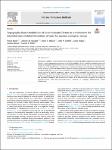Topography-based modulation of environmental factors as a mechanism for intertidal microhabitat formation: A basis for marine ecological design.
| dc.contributor.author | Bauer, F | |
| dc.contributor.author | Knights, AM | |
| dc.contributor.author | Hanley, ME | |
| dc.contributor.author | Griffin, JN | |
| dc.contributor.author | Foggo, A | |
| dc.contributor.author | Brown, A | |
| dc.contributor.author | Firth, LB | |
| dc.date.accessioned | 2024-05-01T10:53:45Z | |
| dc.date.available | 2024-05-01T10:53:45Z | |
| dc.date.issued | 2024-05 | |
| dc.identifier.issn | 1879-3363 | |
| dc.identifier.issn | 1879-3363 | |
| dc.identifier.other | 116358 | |
| dc.identifier.uri | https://pearl.plymouth.ac.uk/handle/10026.1/22389 | |
| dc.description.abstract |
Topographic complexity is often considered to be closely associated with habitat complexity and niche diversity; however, complex topography per se does not imply habitat suitability. Rather, ecologically suitable habitats may emerge if topographic features interact with environmental factors and thereby alter their surrounding microenvironment to the benefit of local organisms (e.g., resource provisioning, stress mitigation). Topography may thus act as a key modulator of abiotic stressors and biotic pressures, particularly in environmentally challenging intertidal systems. Here, we review how topography can alter microhabitat conditions with respect to four resources required by intertidal organisms: a source of energy (light, suspended food particles, prey, detritus), water (hydration, buffering of light, temperature and hydrodynamics), shelter (temperature, wave exposure, predation), and habitat space (substratum area, propagule settlement, movement). We synthesize mechanisms and quantitative findings of how environmental factors can be altered through topography and suggest an organism-centered 'form-follows-ecological-function' approach to designing multifunctional marine infrastructure. | |
| dc.format.extent | 116358-116358 | |
| dc.format.medium | Print-Electronic | |
| dc.language | eng | |
| dc.publisher | Elsevier | |
| dc.subject | Facilitation | |
| dc.subject | Greening of grey infrastructure | |
| dc.subject | Marine eco-engineering | |
| dc.subject | Nature-based solutions | |
| dc.subject | Organismal needs | |
| dc.subject | Substratum structure | |
| dc.title | Topography-based modulation of environmental factors as a mechanism for intertidal microhabitat formation: A basis for marine ecological design. | |
| dc.type | journal-article | |
| dc.type | Journal Article | |
| dc.type | Review | |
| plymouth.author-url | https://www.ncbi.nlm.nih.gov/pubmed/38643588 | |
| plymouth.volume | 202 | |
| plymouth.publisher-url | http://dx.doi.org/10.1016/j.marpolbul.2024.116358 | |
| plymouth.publication-status | Published | |
| plymouth.journal | Marine Pollution Bulletin | |
| dc.identifier.doi | 10.1016/j.marpolbul.2024.116358 | |
| plymouth.organisational-group | |Plymouth | |
| plymouth.organisational-group | |Plymouth|Research Groups | |
| plymouth.organisational-group | |Plymouth|Faculty of Science and Engineering | |
| plymouth.organisational-group | |Plymouth|Faculty of Science and Engineering|School of Biological and Marine Sciences | |
| plymouth.organisational-group | |Plymouth|Research Groups|Marine Institute | |
| plymouth.organisational-group | |Plymouth|REF 2021 Researchers by UoA | |
| plymouth.organisational-group | |Plymouth|Users by role | |
| plymouth.organisational-group | |Plymouth|Users by role|Current Academic staff | |
| plymouth.organisational-group | |Plymouth|REF 2021 Researchers by UoA|UoA06 Agriculture, Veterinary and Food Science | |
| plymouth.organisational-group | |Plymouth|REF 2021 Researchers by UoA|UoA07 Earth Systems and Environmental Sciences | |
| plymouth.organisational-group | |Plymouth|REF 2029 Researchers by UoA | |
| plymouth.organisational-group | |Plymouth|REF 2029 Researchers by UoA|UoA06 Agriculture, Veterinary and Food Science | |
| plymouth.organisational-group | |Plymouth|REF 2029 Researchers by UoA|UoA07 Earth Systems and Environmental Sciences | |
| plymouth.organisational-group | |Plymouth|Users by role|Current Post-Graduate Research students | |
| dc.publisher.place | England | |
| dcterms.dateAccepted | 2024-04-06 | |
| dc.date.updated | 2024-05-01T10:53:44Z | |
| dc.rights.embargodate | 2024-5-3 | |
| dc.identifier.eissn | 1879-3363 | |
| dc.rights.embargoperiod | ||
| rioxxterms.versionofrecord | 10.1016/j.marpolbul.2024.116358 |


